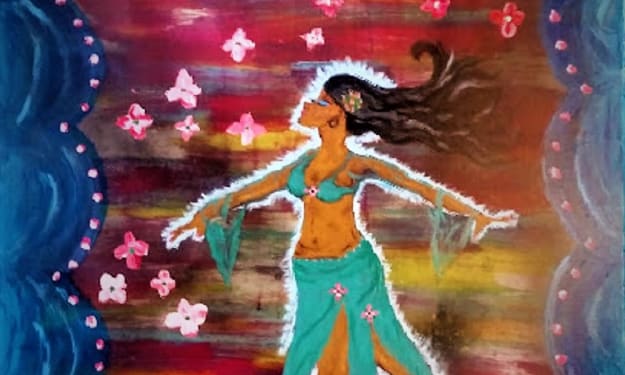The Agency of Stones
Crystals, labyrinths, goddesses, and ancient forests

This is my special crystal. I chose this crystal from a table filled with other pieces broken off some larger quartz. I’ve had it since the summer 1987, a summer I call my “summer of love,” 20 years after the original.
I stood with my friend as we looked over the table hosted by the Rainbow People, a group of hippies who came to Venice Beach to sell their crafts. I held my hand over the stones, “listening” for a call, a sense, a feeling that would tell me which stone was mine.
I felt a warmth, and I knew that this stone, the one with a heart-shaped crack and a little bit of rainbow inside belonged to me.
I believe that all of creation is connected, that the Divine is that which connects us, that calls us to our greater good, whatever that might be.
This view of All That Is cannot see anything, any part of creation, as being absolutely static. Are they sentient, these stones? Perhaps not, at least not in the same way animals are sentient.
Do they have “agency?” I think so, though how this can be is a Mystery. Who is to say that I did not place the meaning of the “warmth” I felt upon the stone; yet, who is to say that the stone didn’t actually “call” to me?
I think the “agency” is in the energy of the stone, and perhaps at quantum level, our energies reached out to one another. Meaning is imbued by a person’s — or a culture’s— understanding of the world around them.
It might change as the culture changes, and the worldview of the people changes. That there is a meaning might continue to be understood long after the original meaning is lost.
Stonehenge and other stone circles have meaning, though the original purpose of such megalithic collections has been lost. Yet today, these stones are held as sacred by modern Druids and other Neo-Pagans, given meaning by the very Mystery that surrounds them.
I have a stone labyrinth in my yard. When I walk into the center, I can easily imagine that I am transcending space and time.

If I walk a labyrinth made of brick, this imaginary time-travel is more difficult.
Why is this? Is it a failing of my imagination, or do the ancient natural stones that line my path lend me their memories?
Once I stood silently in the Petrified Forest in Arizona. The winds blew constant, and upon the winds I could hear the whispers of the trees in the once lush forests so long ago turned to stone.
Perhaps it was only my imagination.
Perhaps it was the memories of the ancient trees.

The Freya Stone

This stone stands next to a picnic area on Piestewa Peak in Phoenix, Arizona. Taller than a person, it somewhat resembles a veiled woman with her arms held close in front of her. This is her home, on the mountainside below the trails.
The park is part of the Phoenix Mountains, with rock formations that rangers say are relatively young — 14 million years. This particular rock stands near a picnic ramada that for many years was used by the local Pagan community for gatherings and community meals.
Memorial Sumbles were held for those who died, with much “huzzah!” and a toss-back of mead, first into the throat and then at the rock along with a memory of the loved one who passed. Though not a gravestone placed over the dead like those in the cemetery, this stone still stands over the spirit of those who crossed over; holding the bits of memories spoken in reverence and love.
When children were present, they found this rock to be a welcome climbing-spot while they awaited the end of a ritual and the call to the table for the sharing of food.
A number of years ago, a small group of Pagan women gathered near this stone, sometimes together and sometimes individually. They took to calling this rock the Freya-Stone after the Nordic goddess of love, beauty, and death.
They spoke to her, and in some way not unlike Annie Dillard’s neighbor,* hoped to teach her to talk, to answer them when they brought their prayers to her, taking small pebbles into their hands and holding them, praying their questions.
Releasing their tears of loneliness, abuse, and self-degradation, they laid the stones on the small shelf of rock where it seems like her hands come together. After their prayers they would share a nibble of bread, a bit of cheese, a few grapes, and a mug of mead, completing their prayers with the “amen” of the splash: thick, dark honey-wine against the Freya-Stone.
One of those women found true love and had her wedding beside the Freya-Stone. Another found self-respect and freedom. The third? Well, she who had also been in abuse and then emptiness found that she had been truly loved for many years. Soon she, too, was wed to a friend she had not known had loved her for so long. In that, she also found her own power, to forge a life beside him.
It is often said by archaeologists and anthropologists that one cannot walk across the desert southwest even a little bit without encountering the remains of Native American life. The “lost” Anasazi left behind sherds of pottery, broken stones, ancient baked agave, an ingenious canal system, and perhaps the spirits of the Pueblo ancestors.
There is no indication that this stone has ever been more than a beautiful, large stone on the side of a beautiful mountain. Yet, gatherings of people of many descents found themselves worshiping near her, sometimes in the company of cougars.
Decidedly, three Euro-American women felt a great power in this stone, and to this day the ones who are still living feel the call to visit her once in awhile, and remember.
*Annie Dillard’s story “Teaching a Stone to Talk” appears in the collection of the same name.
***
This story first appeared as two entries on the author's DreamWidth Blog, In Silent Meditation. Both stories were later published in Brigid's Arrow on Medium as "The Agency of Stones" and "The Freya Stone" © 2015 Suzy Jacobson Cherry All Rights Reserved
About the Creator
Suzy Jacobson Cherry
Writer. Artist. Educator. Interspiritual Priestess. I write poetry, fiction, nonfiction, and thoughts on stuff I love.






Comments
There are no comments for this story
Be the first to respond and start the conversation.